by Margherita Guarducci
© 1960, Hawthorn Books
(all rights reserved)
| Grottoes
Vatican City Colonnade Saints Floorplan #2 |
|
|
|
|
CONTENTS
Introduction
- H. V. Morton
Preface - The Author
Illustrations
I. THE TESTIMONY OF ANCIENT AUTHORS
II. THE VATICAN IN ANCIENT TIMES
III. THE NECROPOLIS UNDER
THE BASILICA
IV. THE APOSTLES MEMORIAL
V. THE TESTIMONY OF THE
INSCRIPTIONS
VI. THE CULT OF THE APOSTLES PETER
AND PAUL ON THE APPIAN WAY
VII. CONCLUSIONS
The Author and Her Book
Pilgrims who cross the threshold of the Vatican basilica usually go right to the papal altar. This, precisely, is the goal of their journey, since there - they know - is the place sacred to St. Peter.
In the center of the area over which Michelangelo's magnificent dome rises, the altar stands majestically above the level of the basilica, protected by the very rich bronze baldacchino, the canopy supported by the ornate columns of Gianlorenzo Bernini. At the foot of the altar, toward the east, is the entrance of the Confessione, a sort of open chapel gleaming with marble and enclosed by a railing on which, day and night, eighty-nine oil lamps gleam in holders of gilded bronze. The faithful, prostrated around the railing, see down in the Confessione where a beautiful marble statue of Pope Pius VI, sculptured by Antonio Canova, kneels in prayer.
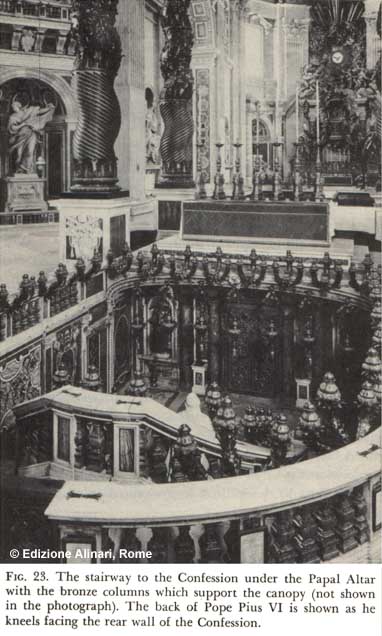 The
Pontiff prays facing toward the rear wall of the Confessione, where the
papal altar rises (Fig. 23). But what is the object of his prayers? What
is there in that wall? There is a rich bronze door, behind which is the
so-called Nicchia dei Pallii (Niche of the Pallia), a small empty place
in which, following a centuries-old tradition, are deposited the sacred
insignia (pallia) which the Pope bestows on some Bishops. And certainly
there is some significance in the fact that the insignia of pastors of
souls are put in this place which represents, for the faithful, the heart
of the basilica and, at the same time, of all Christendom. In fact, the
papal altar under which the Nicchia dei Pallii is found, rises on a series
of superimposed constructions in the most sacred part of the Vatican.
The
Pontiff prays facing toward the rear wall of the Confessione, where the
papal altar rises (Fig. 23). But what is the object of his prayers? What
is there in that wall? There is a rich bronze door, behind which is the
so-called Nicchia dei Pallii (Niche of the Pallia), a small empty place
in which, following a centuries-old tradition, are deposited the sacred
insignia (pallia) which the Pope bestows on some Bishops. And certainly
there is some significance in the fact that the insignia of pastors of
souls are put in this place which represents, for the faithful, the heart
of the basilica and, at the same time, of all Christendom. In fact, the
papal altar under which the Nicchia dei Pallii is found, rises on a series
of superimposed constructions in the most sacred part of the Vatican.
Now let us go down, step by step, to see what is under the altar. And as we go down, it is easy to see that we are also going back through the centuries.
Under the present altar, which belongs to the time of Clement VIII (1592-1605), is the altar of Callistus II (1119-1124); lower still, that of Gregory the Great (590-604). Next we find the monument built in honor of St. Peter by the Emperor Constantine after his victory near the Milvian Bridge (October 28, 312) and the establishment of peace with the Church by the Edict of Milan (313 A.D.). The date of this monument cannot be fixed with absolute certainty, but there are good reasons to think that it preceded the construction of the basilica (begun about 322) and perhaps it is no later than 315; that is, the year in which great holiday were held in Rome to exalt Constantine and his victory; the year in which Rome dedicated the famous Arch of Triumph which still rises majestically from its soil.
Constantine's monument to Peter contained within its rich marble construction an earlier chapel (or, more literally, shrine. M.G.) which has been brought to light by excavations. This chapel indicates, evidently, the place sacred to the Apostle, the place that Constantine considered so important and worthy of honor that he did not hesitate to build on it first his precious monument and later - at the cost of incalculable expense and enormous labor - the great basilica.
The characteristic chapel rises from the level of the ancient necropolis already described. It stands in a little open area, a sort of small square in the middle of various tombs. (See Plate III.) This little area which, in relation to the modern basilica, is directly under the Confession, was called "Field P" by the excavators. It is rectangular in form (about seven meters from north to south, about four from east to west), and it lies in a place where the terrain rises quite rapidly from the south to the north, i.e. toward the Apostolic Palaces, and more gradually from the east to the west, i.e., toward the Vatican Gardens.
Field P is bounded on the west by a wall called "Red" because of the red color of the plaster (now largely fallen off) which was used to cover it; on the south by a tomb which the excavators call S; on the east, but only in the southern half of the east section, by another tomb called O (this tomb was owned by the Matuccii and is sometimes called by their name). The northern boundary of the eastern side and all the northern boundary of the eastern side and all the northern boundary cannot be traced today, but there are good reasons for believing that there were once structures there which have been mostly destroyed.
Behind the Red Wall ran a small street (the so-called clivus) which slopes up from the south to north and includes some sets of stairs (Fig. 24). On the other side of this clivus are the remains of two other tombs, called R and R1 by the excavators. The clivus gave access to the Tomb R1 and to a tomb called Q which lies behind the Red Wall with the Red Wall itself used for its eastern wall.
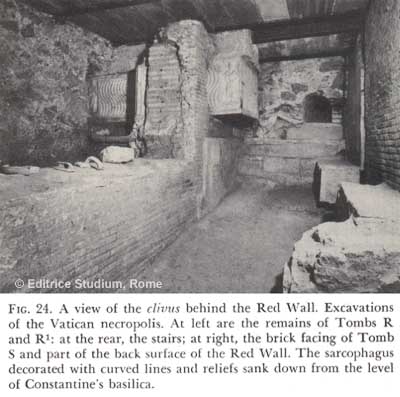 Under
the clivus runs a little gutter used for drainage and covered with a line
of tiles, five of which, fortunately, bear a mark by which they can be
dated. The mark mentions Aurelius Caesar (the future Emperor Marcus Aurelius)
and his wife Faustina as proprietors of the furnace in which the tiles
were made.1 The tiles can therefore be dated between about
146 and 161 A.D. It was about 146 when Faustina, wife of the future Emperor
Marcus Aurelius, received the title of Augusta, and in 161 Aurelius Caesar,
having succeeded Antonius Pius, abandoned the name of Aurelius Caesar
and took that of Marcus Aurelius.
Under
the clivus runs a little gutter used for drainage and covered with a line
of tiles, five of which, fortunately, bear a mark by which they can be
dated. The mark mentions Aurelius Caesar (the future Emperor Marcus Aurelius)
and his wife Faustina as proprietors of the furnace in which the tiles
were made.1 The tiles can therefore be dated between about
146 and 161 A.D. It was about 146 when Faustina, wife of the future Emperor
Marcus Aurelius, received the title of Augusta, and in 161 Aurelius Caesar,
having succeeded Antonius Pius, abandoned the name of Aurelius Caesar
and took that of Marcus Aurelius.
The essential purpose of the Red Wall seems to have been to fix the boundaries of the various burial places in the area. From this fact, it can be considered contemporary with the gutter I have mentioned, and therefore it can be dated between about 146 and 161 A.D. In round numbers, and wishing to take the latest possible date, we can say that it was built by about 160 A.D.
The most ancient of the tombs surrounding Field P is certainly Tomb O, which, as can be seen form the marble tablet over the entrance, belonged to the Matuccii family. This tomb, in which the rite of cremation was practiced, can be dated about 130, and is certainly later than 123, since a brick was found in one of its walls with a seal dating from that year.
The Tomb S, which bounds all the southern flank of Field P, contains traces of cremation urns and of repositories for inhumation. Later than Tomb O, Tomb S is still earlier than the Red Wall, since the wall leans on it, thus barring access to Field P from the south. Therefore Tomb S can be assigned a date somewhere between 130 and 150.
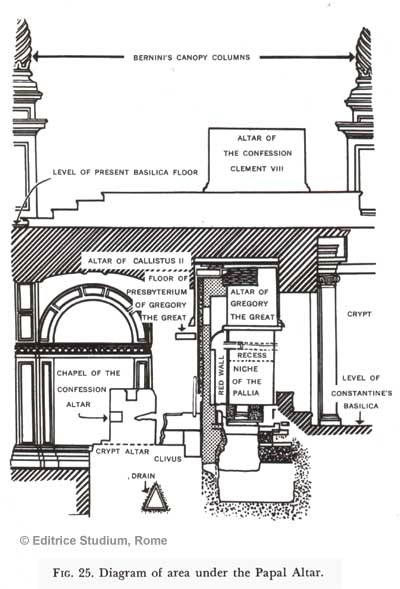 Tomb
R, built on the other side of the clivus, must be more or less contemporary
with Tomb S. Once decorated with fine plaster ornaments, most of which
are lost today, it was considerably damaged, in 1626, by the work on the
foundation of Bernini's baldacchino. This is the exact spot where, in
that year, the tomb of the bon vivant Flavius Agricola was found, with
the inscription2 that, as I have said, aroused such a scandal
that the sarcophagus itself was thrown into the Tiber. For us, Tomb R
has a special interest since its eastern outer wall bears an important
Christian graffito.3
Tomb
R, built on the other side of the clivus, must be more or less contemporary
with Tomb S. Once decorated with fine plaster ornaments, most of which
are lost today, it was considerably damaged, in 1626, by the work on the
foundation of Bernini's baldacchino. This is the exact spot where, in
that year, the tomb of the bon vivant Flavius Agricola was found, with
the inscription2 that, as I have said, aroused such a scandal
that the sarcophagus itself was thrown into the Tiber. For us, Tomb R
has a special interest since its eastern outer wall bears an important
Christian graffito.3
On the same side of the clivus, Tomb R abuts Tomb R1, which was however, constructed later. Still it can be established that this tomb is also earlier than the Red Wall. In Tomb R1 a tile was found with a seal of the same type as that which dated the tiles of the gutter (about 146 to 161 A.D.) In brief, R1 can probably be dated between about 150 and 160.
Even more recent that R1 is the Tomb Q, which could be better described as a burial area consisting of a series of tombs around an open courtyard. Still, Tomb Q seems to belong to a time not much later than the previously mentioned tombs.
These are, in brief, the structures surrounding Field P. But in Field P itself, what did the excavators find?
Field
P was full of burial tombs. Some of these were brought to light during
the 1939-1949 excavations; others in much greater numbers, by the successive
excavations of the years 1955-1957. These tombs are generally quite modest,
situated in the bare ground with little or no protection. Some of them
are certainly older than the Red Wall, i.e., as I have explained, before
about 160 A.D. One of these is the tomb indicated by the excavators with
the Greek letter gamma (![]() ):
a child's tomb which extends partly under the Red Wall, which shows that
it must be older than the wall. A precious clue to establish its date
comes from a seal pressed into one of the tiles covering it. The seal
is dated by scholars at the beginning of the second century (about 115-123),4
and it is quite probable that the tomb is not much later than this date.
Tomb gamma is also interesting because one of its walls contains a terra
cotta tube through which libations were poured from the outside in honor
of the deceased. This is essentially a pagan custom, but it was adopted
for a while by some Christians.
):
a child's tomb which extends partly under the Red Wall, which shows that
it must be older than the wall. A precious clue to establish its date
comes from a seal pressed into one of the tiles covering it. The seal
is dated by scholars at the beginning of the second century (about 115-123),4
and it is quite probable that the tomb is not much later than this date.
Tomb gamma is also interesting because one of its walls contains a terra
cotta tube through which libations were poured from the outside in honor
of the deceased. This is essentially a pagan custom, but it was adopted
for a while by some Christians.
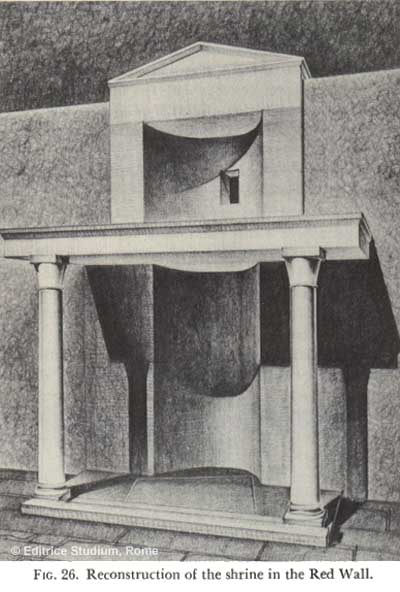 Other
tombs in Field P can be dated earlier than the Red Wall. They are usually
designated by the Greek letters eta (
Other
tombs in Field P can be dated earlier than the Red Wall. They are usually
designated by the Greek letters eta ( ![]() ) and theta (
) and theta ( ![]() ). The first is certainly more ancient than the Red Wall since the two
little columns of St. Peter's Memorial are placed on it, and this monument,
as I shall explain in a moment, is contemporary with the Red Wall. The
second of these tombs (theta) is under Tomb eta and so, necessarily, earlier.
In addition, Tomb theta has, on one of its tiles, a seal that can be dated
in the time of the Emperor Vespasian (69-79). This seal was already discussed
in the chapter on the Vatican in antiquity;5 and the fact that
this tomb belongs to the first century is unquestionable. In addition,
the existence of first-century tombs in this part of the Vatican necropolis
is confirmed, as I have said,6 by other documents, particularly
by a lamp that can be dated with certainly in the first century, found
with other funeral material from the same period in the immediate vicinity
of Tomb theta.
). The first is certainly more ancient than the Red Wall since the two
little columns of St. Peter's Memorial are placed on it, and this monument,
as I shall explain in a moment, is contemporary with the Red Wall. The
second of these tombs (theta) is under Tomb eta and so, necessarily, earlier.
In addition, Tomb theta has, on one of its tiles, a seal that can be dated
in the time of the Emperor Vespasian (69-79). This seal was already discussed
in the chapter on the Vatican in antiquity;5 and the fact that
this tomb belongs to the first century is unquestionable. In addition,
the existence of first-century tombs in this part of the Vatican necropolis
is confirmed, as I have said,6 by other documents, particularly
by a lamp that can be dated with certainly in the first century, found
with other funeral material from the same period in the immediate vicinity
of Tomb theta.
All these tombs of Field P are, for us, anonymous, since none of them has preserved an epigraph in which the name of the deceased is indicated. But it is quite probable that in ancient times the names (at least some of them) were carved on tombstones rising out of the ground and that these were later lost during the many vicissitudes of the region.
The very position of this shrine demonstrates its supreme importance. From ancient times until the present, it has suffered much destruction and reconstruction with consequent changes in appearance. Still, the elements which remain, studied attentively by the first excavators, have allowed them to set up a very reasonable reconstruction of it. We might almost class this reconstruction as a certitude (Fig. 26). According to the reconstruction, the building has two niches, one above the other, both cut into the Red Wall. The lower niche is 0.72 meters in width, 1.40 meters in height; the upper one, about 1.10 in width, and its height uncertain. Between the two niches, a slab of travertine is inserted horizontally, jutting out, like a table, about one meter from the side of the Red Wall. It is supported by two small marble columns (Fig. 28), located in front and on either side of the lower niche. In the floor of the shrine, there is a trap door which I shall discuss later. It is important to note that the two niches were not indented into the Red Wall after its construction, but were included in its design when it was being built. This fact is established beyond question by a detailed study of technical points. We can state positively, then, that the chapel's date is the same as that of the wall, around 160 A.D.
Under the two niches which form part of the chapel, there is another, very coarse and irregular niche in the foundation of the Red Wall. Various theories have been offered to explain the nature and purpose of this niche, but none has been powerful enough to eliminate all doubt. Therefore we shall leave the question open, waiting for the day when a satisfactory answer is found. The names given to the three niches by the first excavators are N1, N2, and N3. The niche in the foundation is N1, while N2 and N3 are, respectively, the lower and upper niches in the wall itself.
Whoever built the chapel certainly intended it to mark a place of outstanding importance, to preserve a memory for transmission to future generations.
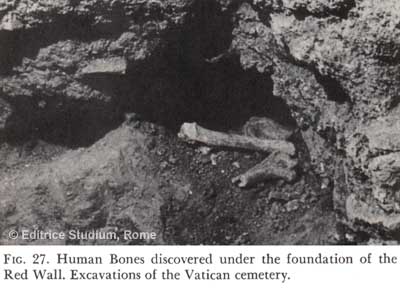 But
what did the excavators find in the necropolis under the chapel. They
found clear evidence of an ancient trench, exactly parallel - and this
is a point of great significance - to the Tombs gamma and theta, which
(as I have already explained) date back to before the building of the
Red Wall. A little wall, called m1 by the excavators, bounded
this trench on the south, separating it from the ancient Tomb gamma; there
was probably a similar wall on the north. These walls, built apparently
in the first half of the second century, correspond to the two long sides
of the trench on which the chapel was built. All around, the ground was
full of coins, which could be dated from the first to the fifteenth century;
these were obviously thrown here by pilgrims who came from near and far
to honor the Apostle. There are four first-century coins among those found
by the excavators: one from the time of Augustus (43 B.C.-14 A.D.) and
three of the Emperor Domitian (81-96 A.D.)
But
what did the excavators find in the necropolis under the chapel. They
found clear evidence of an ancient trench, exactly parallel - and this
is a point of great significance - to the Tombs gamma and theta, which
(as I have already explained) date back to before the building of the
Red Wall. A little wall, called m1 by the excavators, bounded
this trench on the south, separating it from the ancient Tomb gamma; there
was probably a similar wall on the north. These walls, built apparently
in the first half of the second century, correspond to the two long sides
of the trench on which the chapel was built. All around, the ground was
full of coins, which could be dated from the first to the fifteenth century;
these were obviously thrown here by pilgrims who came from near and far
to honor the Apostle. There are four first-century coins among those found
by the excavators: one from the time of Augustus (43 B.C.-14 A.D.) and
three of the Emperor Domitian (81-96 A.D.)
Under the foundations of the Red Wall, and exactly under the niche N1, the excavators found a group of human bones. These bones have been given to specialists for examination and cataloguing. The delicate work, which naturally requires long time and infinite patience, is not yet finished and therefore it is too early to give any conclusions on this discovery. We can only say that in ancient times these bones were placed together under the chapel with a determined purpose of preserving them. And since this place was of exceptional importance (the very existence of the chapel shows that quite clearly) these bones must also represent something exceptional.
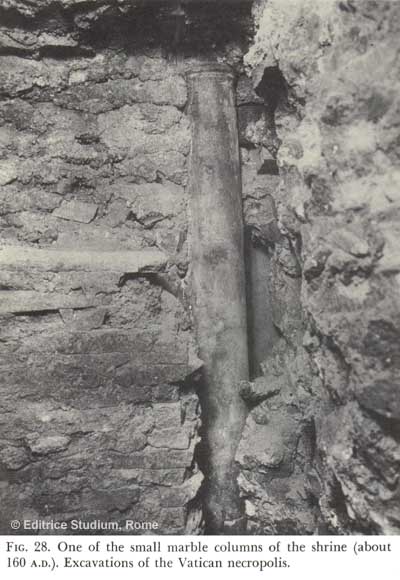 There
can be no question (virtually all scholars admit it) that the chapel is
identical with that "trophy" of Peter proudly mentioned, only a few years
after its construction, by the learned Roman priest Gaius in his controversy
with the heretic Proclus.7 It is also probable that this chapel
is the "Memorial of St. Peter" recorded by the Liber Pontificalis among
the works of Pope Anacletus (memoriam beati Petri construxit).8
It is true that Anacletus was Pope at the end of the first century, and
that this date does not (as far as we can determine) agree with the date
of our chapel; but there is a very suggestive theory supported by some
scholars: that in the text of the Liber Pontificalis there is a confusion
between Anacletus and Anicetus. The latter, indeed, occupied the papal
throne from 155 to 166, a period which would coincide perfectly with the
age of the chapel.
There
can be no question (virtually all scholars admit it) that the chapel is
identical with that "trophy" of Peter proudly mentioned, only a few years
after its construction, by the learned Roman priest Gaius in his controversy
with the heretic Proclus.7 It is also probable that this chapel
is the "Memorial of St. Peter" recorded by the Liber Pontificalis among
the works of Pope Anacletus (memoriam beati Petri construxit).8
It is true that Anacletus was Pope at the end of the first century, and
that this date does not (as far as we can determine) agree with the date
of our chapel; but there is a very suggestive theory supported by some
scholars: that in the text of the Liber Pontificalis there is a confusion
between Anacletus and Anicetus. The latter, indeed, occupied the papal
throne from 155 to 166, a period which would coincide perfectly with the
age of the chapel.
Between the time of its construction (about 160) and the time when it was enclosed in Constantine's monument (about 315) the chapel underwent modifications and additions. Thus, about the middle of the third century, another wall (called G by the excavators) was built perpendicular to the Red Wall to help support it and cover a fissure just to the right of the chapel. This wall, 0.87 meters in length and 0.45 meters thick, is the same Wall G on whose northern side are incised the precious graffiti which I shall discuss in the next chapter. To build Wall G, it was necessary to shorten slightly the northern side off the travertine "table" between niches N2 and N3 and to shift the small marble pillar on the northern side slightly to the south. This disturbed the harmony of the chapel's structure. In compensation, it was decided to enrich the monument by covering the floor and the walls on either side of niche N2 with marble. Next, another wall was built (Wall S) parallel to Wall G, and the inner sides of both walls (which now enclosed the chapel on its northern and southern sides) were also faced with marble. Finally, the two small columns were (or seem to have been) connected by a lattice.
Wall G is generally considered a supporting wall, built to shore up the sagging Red Wall. But this opinion may leave room for some doubt; at any rate the addition of Wall G had the undeniable purpose of stabilizing a place of special interest. This interest is also shown by a white mosaic pavement, with a green band around the circumference, which was placed upon the whole of Field P, as though to decorate the surroundings of the Apostle's Memorial with a precious covering.
In summary, we can say that those who built the Red Wall and its chapel, about the middle of the second century, had the precise intention of marking a place sacred to the Apostle Peter. It has been rightly observed that it would have been simpler to build the chapel beside the Red Wall, instead of laboriously indenting it into the wall. This extra effort shows a desire to indicate with absolute exactitude a place that was considered more precious than any other.9
But what place did they wish to indicate? Since we are dealing with St. Peter and the Vatican, there can be only two possibilities: the site of the Apostle's martyrdom or that of his tomb.
Some scholars have preferred the former theory; but it is not an easy one to support. In the first place, it is absurd to imagine that in second-century Rome it would be desirable or possible to place a public monument on the spot where a condemned man had been crucified. In addition, this part of the Vatican was certainly outside of Nero's arena, where Peter probably suffered martyrdom. Finally, if the chapel had been built to mark the site of Peter's crucifixion, it would not have been necessary to calculate its location so precisely.
If we
exclude the theory that the chapel marks the site of martyrdom, the only
alternative is to admit that it refers to the tomb. And in fact the faithful
who built it believed that Peter's tomb was precisely there; this is shown
not only by their care in marking this particular place with such absolute
precision, but also by other indications. These include: the funereal
character of the chapel itself, which resembles other chapels of the period
found in the cemetery of St. Sebastian on the Appian Way and the one on
the Sacred Isle near Ostia; the sepulchral significance that Gaius certainly
gave to the word "trophy" (![]() ) which he used to signify this chapel sacred to Peter;10 and, above all,
a graffito carved near to the chapel itself, which - as I shall explain
in the next chapter - tells us explicitly of Peter's burial in this place.11
) which he used to signify this chapel sacred to Peter;10 and, above all,
a graffito carved near to the chapel itself, which - as I shall explain
in the next chapter - tells us explicitly of Peter's burial in this place.11
The Christians who lived in Rome about the middle of the second century, therefore, were convinced that Peter's tomb was precisely here. Was this conviction actually well-founded?
Some people have simply denied the existence of Peter's tomb, thinking that it would be impossible to recognize the man's remains in the horrible mass of flesh piled up in Nero's gardens after the barbaric spectacle. But this objection has little value. It can hardly be believed that the faithful would not follow their own martyrs' dramatic and glorious actions to the very end; or that afterward they would have neglected to bury their bodies, or whatever pitiful remains could be found. Thus, in the Epistle already mentioned,12 which Ignatius, Bishop of Antioch, wrote to the Romans while he was going toward his martyrdom (in 107 A.D., as far as we can tell) he prays that the beasts will consume his entire body "so that, after my death, I may not be a burden to anyone." This means that his friends (some of whom had already gone to Rome to witness his martyrdom) were planning - no matter what toil and danger might be involved - to gather the precious remains of the Martyr. The same must be said of Peter, more so since his body, hanging on a cross, could be much more easily watched and recovered by the faithful.
The middle of the second century was still quite close to the year (65 or perhaps, 67 A.D.) in which Peter suffered martyrdom. With a few rare exceptions, the Apostle's contemporaries must have been dead; but there would be many still alive whose fathers had known him in person and followed the events of his death. The popular opinion of the faithful on the precise location of his tomb in the Vatican necropolis, therefore, has considerable weight.
But what do the excavations reveal on this question? I have already mentioned that the excavators found evidence of a very ancient trench under the chapel. The fact that this trench was a grave is shown by the funereal quality of the area; we have seen13 that it already had this quality in the first century, i.e., at the time of the Apostle. More confirmation comes from a trap door in the floor of the Memorial. This trap door, which exists today only in its outlines, is orientated not, as might have been expected, according to the architectonic lines of the Memorial, but according to the lines of the trench underneath. The trench, in turn, is orientated exactly like the ancient tombs theta and gamma. This shows - it is hard to deny it - that the trench was considered very important by those who built the Memorial, and also that it was a grave.
There is nothing in archaeology, not in logic, to make us deny the existence of Peter's tomb under the chapel in the Red Wall.
But why, the question arises, was the presumptive grave under the chapel found laregely destroyed, and why was a small deposit of bones found, instead, under niche N1? The answer to this question is that from the first century on this area underwent various disturbances: first of all in the second century for the construction of rich mausolea and of the Red Wall; later, about the middle of the third century, for the construction of Wall G. Theoretically, it can be admitted that, in the course of the works I have mentioned, it was considered appropriate to bring together, under the Red Wall's foundation, the bones which had been found in the immediate vicinity.
In this case, it is possible that at least some of these remains are relics of St. Peter.